The relay-based version of the YGREC-8 was in limbo due to delays in the delivery of required parts. I'm expecting more RES-64 to arrive in a few weeks, after ridiculous back-and-forth between post offices on strike. Meanwhile I was able to progress with #VHDL library for gate-level verification in amazing ways but... My soldering iron is asking for action !
Fortunately I received other parts from Russia (thank you eBay !) and I'm listing them to keep track of their intended use.
Those parts are pretty oversized, compared to today's technology, but the looks/appearance/style is worth it and the whole will be coherent ;-)
20× PETP K73-16 63V 2.2µF
These are non-polarised capacitors with medium value.

They are useful for 2 cases :
- for CCPBRL: the coupling between stages requires a capacitor but a polarised one forces the use of two shifted power supply domains. Non-polarised capacitors simplify the power supply design, as well as logic design in some corner cases. However, 2.2µF might not cut it for the RES-15...
- for the high-fanout buffers such as the ones described below:
![]() Some simulations with Falstad have shown that a high value would create an oscillation thatcould interfere with the rest of the circuit. A low value however wouldn't transfer enough energy from one side to the other. In both cases, the purpose is to prevent arcing at the contacts of the control relay at the bottom of the drawing.
Some simulations with Falstad have shown that a high value would create an oscillation thatcould interfere with the rest of the circuit. A low value however wouldn't transfer enough energy from one side to the other. In both cases, the purpose is to prevent arcing at the contacts of the control relay at the bottom of the drawing.
I don't think the YGREC8 needs 20 high-fanout signals but at least I'll be ready. The data memory system requires 5 buffers, the instruction memory might need a few more, but it is a reasonable approximation.
Of course I'll have to experiment, test, verify, measure... I expect to make another video when it's done :-)
| Verdict : great surprise ! These capacitors aged very well and maintained excellent isolation as well as precise capacitance : +/- 2% worst case ! I don't know about the inductance but it should work very well. |
20× Inductances Kig 0.1 1000μH
High-value, low-current inductors
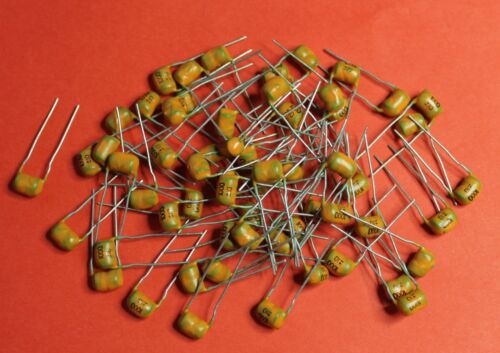
These parts will "isolate" the various bitplanes from the main power supply.
Each of the 8 bitplanes contains at least 16 RES-64 to store the values from the register set, but these planes are quite sensitive to external interferences. A "pi" network is used : each bitplane has a local large-value capacitor, added to the large value of the power supply, and the bitplanes can emit and receive pulses that could flip other states...
The current rating is low but compatible with a single bitplane : each relay uses approx. 2.5ma, a total of 20mA, this gives a 5× margin with this 100mA part.
| Verdict : good ! 8.5-9.1 ohms is a bit much, but the inductance is around 960µH, a few percents of variation. It should work well... |
8x Capacitor K50-24 16 V 2200µF
high-value, medium-voltage power-storage capacitor
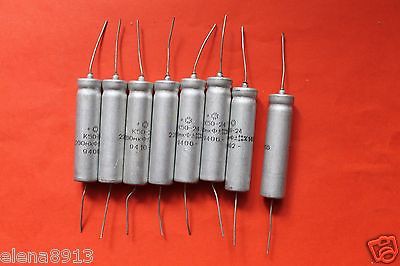
There are 8 of them, just as needed for the 8 bitplanes. Ideally they filter the power to the 16×RES-64. However due to the high capacity and the low current rating for the inductor, there is the risk of blowing up the inductor in the case where the input is (accidentally) shorted. A series germanium diode (or 2 in parallel for higher current capacity and longevity) would prevent the damage.
| Verdict : These parts aged but should be "good enough", with a self-resistance around 1M and average capacitance in the 1600-1800µF range. ESR might be high though. They can be for local power supply filtering. |
.
Update:
I have "reformed" the capacitors through the slow and long application of current and the leakage has been significantly reduced.
I applied this method to the larger caps below as well.
8× K50-16 25 V 5000µF
These big babies belong obviously in the power supply.
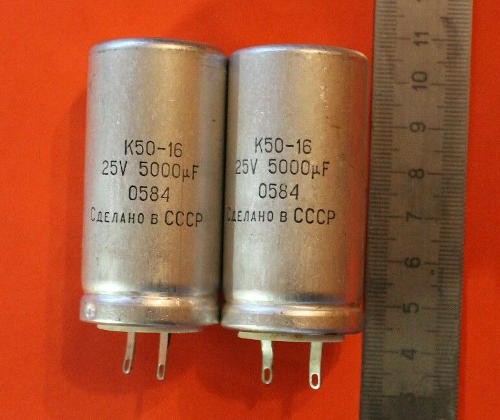
Not much more to say. It's going to be quite massive but I want to avoid as much ripple as possible.
There will be several voltages so at least a couple will be used for each rail, depending on the needed current.
| Verdict : something bad happened, probably a breach because there is liquid in the bag. Probably the electrolyte... I'll have to get others and/or use my "modern" stock. |
40× K50-20 100 V 10uF
Those are temporary bit storage caps for the Flip-Flops. 4.7µF would work too.
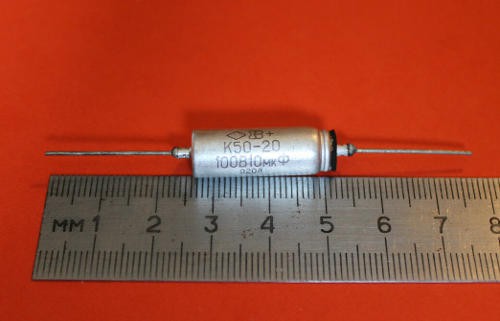
The value would be charged through a resistor (TBD) to reduce interference and spikes on the supply rail. The capacitor is discharged in the middle point of the two RES-64 in series, acting as inductors, so there is current reduction to add on that side.
Niobium is an alternative to tantalum, so the ESR is much lower than the electrolytic capacitors and it should be able "kick" the current pretty fast and counter the reverse EMF.
BTW : the + pole is at the black end (thanks @Artem Kashkanov !)
I need 8 of them for the write-back latch that feeds the write port of the register set, but other capacitors are required for the other Flip-Flops in the system, such as the PC counter, even counters, ...
| Verdict: Some parts seem to have a bit of gunk but appear functional. Capacitance is good, ranging from 10 to 11.7µF. Resistance/leakage is easily measurable (>1M) but good enough to work for short pulses. Extra/leftover parts will reinforce the filtering of the power supplies. |
I also have received 30× axial tantalum K53-14 10µF 10V capacitors. The average capacitance is measured at 9µF (+/- 0.3µF) and it's smaller so more practical for the latches.
20× Niobium K53-4 20 V 47µF
Clearly useful to complement the large, high-ESR electrolytic capacitors for filtering the power supplies here and there (for the low and medium voltages up to around 12V). Two in series are mandated for filtering the 24V rail, made of a symmetric +12V/0V/-12V supply.
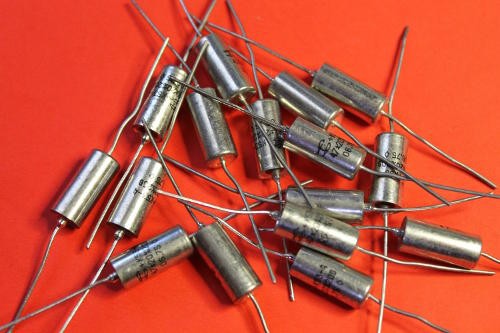
BTW : the + pole is at the black end (thanks @Artem Kashkanov !)
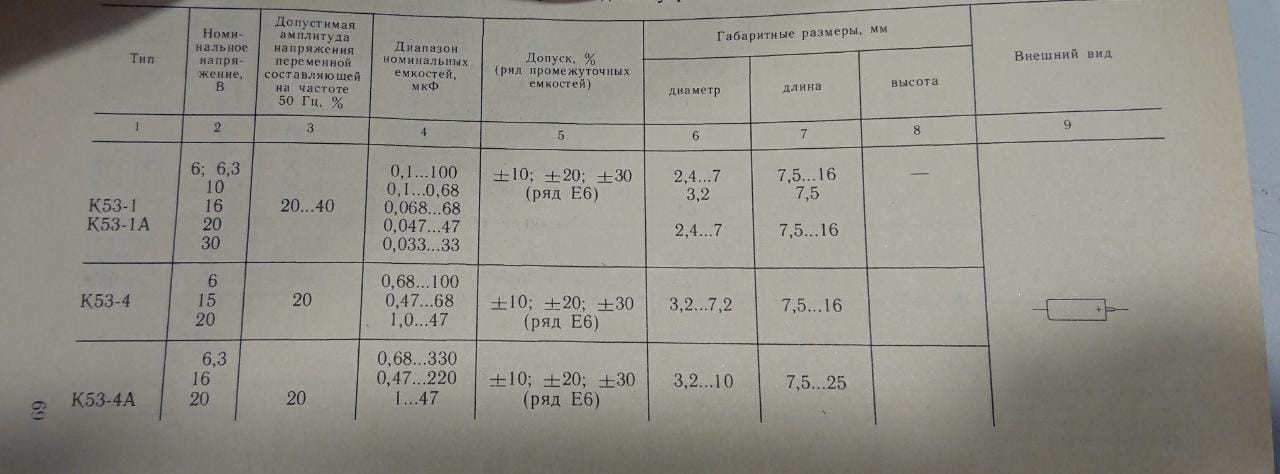
| Verdict : These parts aged and even if one is 60µF, many others are under 47µF, in the 37-43µF range. There is some tiny current leakage but these should be good enough, though. |
So that's it.
It's going to be a bold, large, bloated but exquisitely exotic board...
 Yann Guidon / YGDES
Yann Guidon / YGDES
Discussions
Become a Hackaday.io Member
Create an account to leave a comment. Already have an account? Log In.